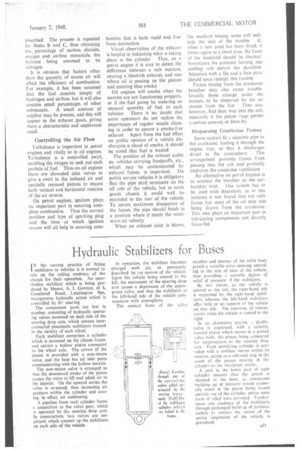Hydraulic Stabilizers for Buses
Page 33

If you've noticed an error in this article please click here to report it so we can fix it.
1-N the current practice of fitting / stabilizers to vehicles it is normal to rely on the rolling tendency of the chassis for their operation. An unorthodox stabilizer which is being produced by Messrs. A. J. Gorman, of 6, Greatheed Road, Leamington Spa, incorporates hydraulic action which is controlled by the steering The component parts are few in number, consisting of pydraulic operating valves mountedon each side of the steering drop arm, which actuateinterconnected pneumatic stabilizers located in the vicinity of each wheel.
Each stabilizer comprises a cylinder which is mounted on the chassis frame, and carries a hollow piston connected to the wheel axle. The crown of the piston is provided with a non-return valve, and the base has air inlet ports communicating with the hollow interior.
The non-return valve is arranged so that the downward stroke of the piston causes the valve to lift and admit air to the interior. On the upward stroke the valve is re-seated, thus increasing air pressure within the cylinder and -causing, in effect, air cushioning.
A pipeline from each cylinder forms a connection to the valve gear, which is operated by the steering drop arm. In construction, two valves are employed, which connect up the stabilizers on each side of the vehicle. ln operation, the stabilizer becomes charged with air, as previously described by tire motion of the vehicle. Upon the vehicle being steered to the left, the movement of the steering drop arm causes a depression of the appropriate valve, and thus the stabilizers at the left-hand side of the vehicle communicate with atmosphere.
The conical form of the valve
member and interior of the valve body permit a variable valve opening, according to the rate of turn of the vehicle. thus providing a variable degree of relief of pressure if the stabilizers.
By this means, as the vehicle is steered to the left, the right-hand side is supported by the right-hand stabilizers, whereas the left-hand stabilizers offer little or no support of the vehicle on that side. The converse, of course, occurs when the vehicle is steered to the right.
In an alternative system. • double valve is employed, with a suitably formed piston which moves in a ported valve body, the piston being connected for reciprocation to the steering drop arm. Each stabilizing cylinder is provided with a resilient means within its interior, acting as a rebound stop in the event of the piston moving in the cylinder to the maximum extent.
A port in the lower part of each cylinder ensures that the piston is retained in the bore, as continuous building up of pressure would eventually result in the piston being forced entirely out of the cylinder, unless some form of relief were provided. Furthermore. any tendency of the stabilizers, through prolonged build-up of pressure. unduly to restrain the action of the spring suspension of the vehicle, is prevented,












































































